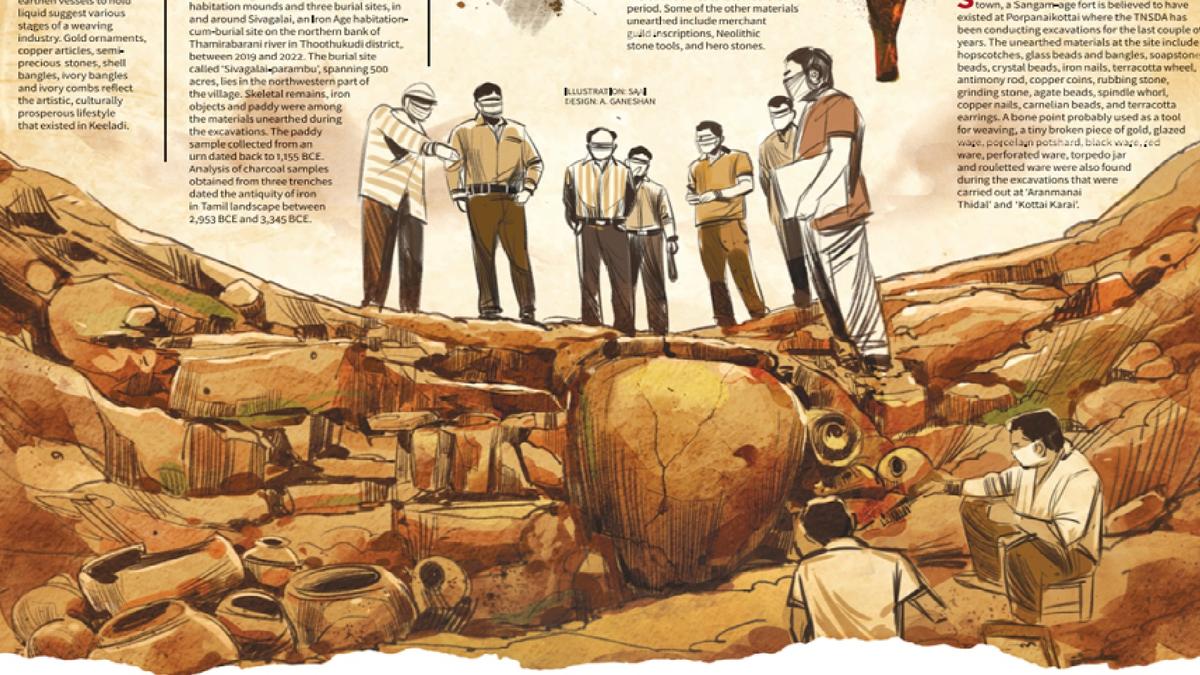
Unearthing an ancient Tamil civilisation
The Hindu
Tamil Nadu's archaeological milestones in 2025 include the discovery of the Indus Valley script and ancient iron usage.
The beginning of 2025 marked a significant milestone in the history and archaeology of Tamil Nadu with the State government making two major announcements.
While inaugurating the three-day International Conference on the centenary of the discovery of the Indus Valley Civilisation in Chennai on January 5, Chief Minister M.K. Stalin announced a $1 million prize for experts or organisations that succeed in deciphering the scripts of the Indus Valley Civilisation.
A couple of weeks later, on January 23, he released a report, ‘Antiquity of Iron: Recent radiometric dates from Tamil Nadu’ and announced: “The Iron Age began on Tamil soil. The antiquity of iron in the Tamil landscape dates back to the first quarter of the 4th millennium BCE.” Citing the carbon dating results, he said the usage of iron was prominent in south India over 5,300 years ago. These announcements have shifted the spotlight towards the findings of various excavations carried out by the Archaeological Survey of India (ASI) and Tamil Nadu State Department of Archaeology (TNSDA) in Tamil Nadu over the years.
The antiquity of iron in the Tamil landscape, dating back to the first quarter of the 4th millennium BCE, was based on samples drawn from archaeological excavations carried out here. The TNSDA excavated eight locations, including five habitation mounds and three burial sites, in and around Sivagalai, an Iron Age habitation-cum-burial site on the northern bank of Thamirabarani river in Thoothukudi district, between 2019 and 2022. The burial site called ‘Sivagalai-parambu’, spanning 500 acres, lies in the northwestern part of the village. Skeletal remains, iron objects and paddy grains were among the objects unearthed during the excavations. The paddy sample collected from an urn dated back to 1,155 BCE. Analysis of charcoal samples obtained from three trenches dated the antiquity of iron in Tamil landscape between 2,953 BCE and 3,345 BCE.
Located on the northern bank of Thamirabarani river in Thoothukudi district, Adichanallur was first excavated by F. Jagor, a German Archaeologist, in 1876. It was subsequently excavated by British officer Alexander Rea between 1902 and 1904. Nearly 100 years later, ASI did an excavation in 2004-05. The ASI and TNSDA conducted excavations again between 2019 and 2023. These series of excavations yielded a wealth of materials, including gold diadems, metals, human remains such as bones, microlithic tools belonging to the Stone Age, female figurines, iron weapons and potsherds with Tamil-Brahmi inscriptions. The charcoal sample collected in association with iron objects found here in the habitation mound dated the usage of iron to mid of the 3rd millennium BCE.
A series of excavations by ASI and TNSDA at Keeladi, a hamlet in the Sivaganga district located 12 kilometers south-east of Madurai, since 2015, have proved that an urban civilisation existed in the ancient Tamil landscape on the banks of Vaigai river. K. Amarnath Ramakrishna, the then Superintending Archaeologist of ASI, discovered and oversaw the first two phases of excavations. Heaps of pottery unearthed here suggested the existence of a pottery-making industry that flourished using locally available raw materials. Hundreds of potsherds containing Tamil Brahmi inscriptions were found. Spindle whorls, copper needles, terracotta seals, hanging stones of the yarn, terracotta spheres and earthen vessels to hold liquid suggest various stages of a weaving industry. Gold ornaments, copper articles, semi-precious stones, shell bangles, ivory bangles and ivory combs reflect the artistic, culturally prosperous lifestyle that existed in Keeladi.
The materials unearthed during the excavations by TNSDA in the ancient port town of Korkai in Thoothukudi district in 1968-69 and in recent years had shed light on the long-established trade relations of ancient Tamil Nadu. On-shore excavations have been taken up since the late 1960s point to the existence of a shell bangle-making industry. Organic materials found during the excavations date back to 785 BCE. Several fully intact, many half-cut and numerous fully broken conch shells were also found showing evidence of manufacturing of ornaments. Black Slipped ware of Gangetic plains, nine-storeyed perforated filtering pipe, and a large pot placed in the centre of a brick structure were also unearthed.













